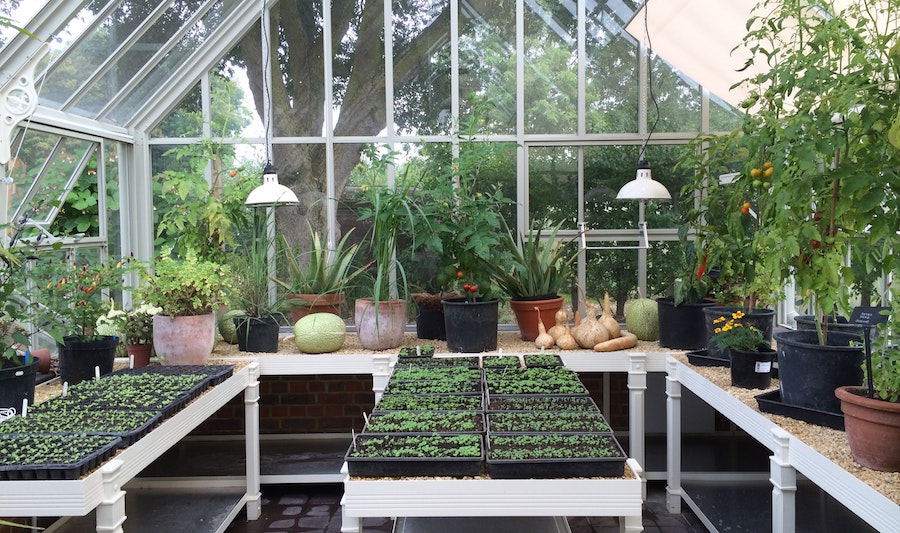5 tips to make the most of your greenhouse this autumn
As the weather gets cooler, Matthew Biggs offers 5 tips on what to do in the greenhouse to ensure you’re ready for winter.
Autumn offers a useful window of opportunity in the greenhouse to ensure you’re prepared for winter.
Gardening expert, author and broadcaster Matthew Biggs, a regular panellist on BBC Radio 4’s Gardeners’ Question Time, offers the following tips on greenhouse jobs for autumn.
1. Sow while it’s warm

Sow seeds while it’s still warm
While it is still warm and sunny, sow trays, pots or old growing bags in your greenhouse with ‘cut and come again’ crops which you can harvest throughout autumn and into winter.
If you are looking for inspirational species ideas, try land cress, oriental salad leaves like pak choi, mizuna and mibuna. Or stick to classic lettuce varieties, like ‘Valdor’, chicory and radishes. You can also add brassica crops for microgreens which you can harvest earlier.
2. Grow out-of-season flowers

Forced hyacinths should do well under greenhouse staging
By providing extra warmth, plants which are normally dormant during early autumn and winter months can be ‘woken early’ and will look their best several months ahead of those grown naturally outdoors.
Some, such as hyacinths, are often available as ‘prepared’ bulbs, which means they have been treated to simulate an artificial winter and will therefore spring into growth as soon as planted. Buy quality bulbs in autumn and plant closely in pots using peat-free potting compost and keep them in cool, deep shade under the greenhouse bench until the leaves are 5cm long.
If you have a greenhouse bed and have grown summer food crops, a good autumn and winter use for the vacant space is to raise cut flowers.

Start freesias off in the greenhouse
Freesias can be grown for display or cutting and flower naturally in late winter and thrive in a cool greenhouse.
3. Clear up

Give the greenhouse a good clean
Along with spring, autumn provides a natural opportunity to do some essential greenhouse cleaning.
Aim to clean up both the inside and outside of your greenhouse on a warm, dry autumn day. Clean the windows of your greenhouse, paying attention to the individual frames.
Remove moss from overlapping panes with an old kitchen knife or plant label. Use a cleaning product which is suited to your particular greenhouse’s glazing system.
4. Check guttering
Check your gutters are clear of leaves and clean down pipes. Scoop leaves out with your hands, wearing gloves, and flush debris away with a hosepipe or watering can.
While protecting and removing any delicate plants, clean the floor of your greenhouse and disinfect all benches, shelving and equipment.
5. Get ready for winter

Check your greenhouse heater is working
Check your greenhouse heater to make sure it’s working.
There are pros and cons to insulating the greenhouse with bubble wrap in winter. For many gardeners, myself included, it’s not one of my favourite jobs.

There are pros and cons to using bubble wrap
If you do choose to do it, an important consideration is to maintain a balance between the amount of light, heat conservation and ventilation.
Full insulation reduces the amount of light coming into the greenhouse and increases humidity, which can cause disease problems. To minimise this, be sure to remember to cut holes for the ventilators.
If you live in an area where winters are usually mild, it is worth taking the gamble of not insulating at all but have a heater and protective layers on standby should the weather change. If plants need more than protection from frost, wrap them individually with fleece in the greenhouse.
The Press Association
Latest posts by The Press Association (see all)
- What you need to know about weight loss jabs and how to make them work effectively - April 25, 2025
- Is our skin more susceptible to sun damage as we age? - April 25, 2025
- Special stamps to mark 80th anniversary of VE Day - April 24, 2025
- Test your knowledge with our penguin-themed quiz - April 24, 2025
- Prince Louis shows off missing front teeth in new photo to mark seventh birthday - April 23, 2025



















